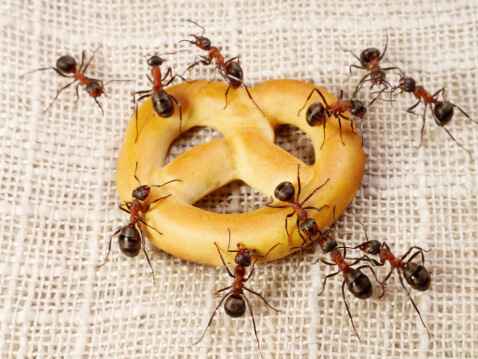
Top 10 Ways to Get Rid of Ants
Ants are a frequent invader of homes across America with small, sweet-eating ants being the most common. They enter in search of food and water and stay because those necessities are so readily available in modern homes. Trailing ants in the home are far more frustrating than ants at a picnic, however, and these ideas will help you get rid of them.
- All cracks and crevices, no matter how tiny, will need to be sealed in interior and exterior walls, in floors, and around doorways and windows. Though it can be time consuming to seek out all of these openings, sealing them is a great help in preventing ants that nest outdoors from entering the home.
- Ants need water just like humans, which is why they are commonly found in bathrooms even though there is no food source present. Water leaks from faucets, pipes, or hoses should be repaired to discourage ants from seeking their drinks inside your home. In severe infestations, it may be necessary to dry out sinks, tubs, and showers after each use.
- All possible food sources need to be removed to further discourage ants from considering your home a great place to stay. Of course, crumbs and spills on counters, floors, and shelves should be wiped up immediately. Foods in the pantry may need to be sealed in airtight containers since tiny ants can easily work their way into folded bags or boxes.
- A residual insecticide, not an ant repellent, should be sprayed around the exterior of all doors, windows, vents, and other access points. Hiring a professional exterminator to do this is usually the best choice because they use insecticides that are much more powerful and effective than those available to consumers.
- Ant baits combine lethal but slow-acting insecticide with a food source that ants dearly love. As they find it, ants will eat some bait and carry some back into the nest to feed their fellow ants. This makes baiting an excellent way to reach all of the ants in the colony. Baits should be placed in areas where the ants have been observed trailing or foraging.
- It’s important to avoid spraying insecticides where ant baits are located. If a liquid insecticide comes into contact with a bait, it can actually destroy the bait’s effectiveness. Most experts recommend waiting at least two weeks after an area has been sprayed before placing baits in that location.
- No matter what, ants that are trailing to a bait station should never be killed – whether by squishing, spraying, or another method. It can be quite unnerving to see what looks like hundreds of ants forming a long line into your pantry, but you must remember that each one is carrying poison to the thousands of ants in the nest. The more poison that is taken into the nest, the quicker the colony can be destroyed.
- Professional exterminators can use a solution of insecticide diluted in water to effectively drench an ant nest. It will require some searching to find the mound where ants are traveling to and from your home, but, if it can be located, drenching with a few gallons of diluted insecticide is usually enough to kill all of the ants inside.
- Destroying only one nest may not kill the entire colony. Well-established ant colonies often build satellite nests in the area around their main nest. They may even build nests inside the insulation or wall voids of a home. No matter how many satellite nests the colony has, however, the queen remains the hub. As long as she survives, the colony will continue. The goal of baiting, of course, is to reach the queen with the poison, but it can also be a good idea to seek out all the related ant hills in the vicinity of your home. An experienced exterminator can often determine if a mound is home to the ants that are invading your home or to another species.
- If ants have established themselves within the walls of your home, a professional can apply insecticidal dust. Small holes are drilled near the base of walls, and the dust is puffed into the void. As ants crawl through, they become covered with the lethal dust.